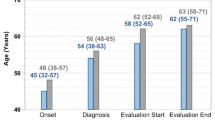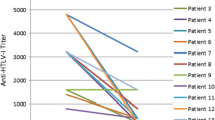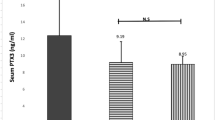Abstract
The main therapeutic strategy against human T lymphotropic virus type I (HTLV-I)-associated myelopathy/tropical spastic paraparesis (HAM/TSP) characterized by lower extremity motor dysfunction is immunomodulatory treatment, with drugs such as corticosteroid hormone and interferon-α, at present. However, there are many issues in long-term treatment with these drugs, such as insufficient effects and various side effects. We now urgently need to develop other therapeutic strategies. The heparinoid, pentosan polysulfate sodium (PPS), has been safely used in Europe for the past 50 years as a thrombosis prophylaxis and for the treatment of phlebitis. We conducted a clinical trial to test the effect of subcutaneous administration of PPS in 12 patients with HAM/TSP in an open-labeled design. There was a marked improvement in lower extremity motor function, based on reduced spasticity, such as a reduced time required for walking 10 m and descending a flight of stairs. There were no significant changes in HTLV-I proviral copy numbers in peripheral blood contrary to the inhibitory effect of PPS in vitro for intercellular spread of HTLV-I. However, serum soluble vascular cell adhesion molecule (sVCAM)-1 was significantly increased without significant changes of serum level of chemokines (CXCL10 and CCL2). There was a positive correlation between increased sVCAM-1and reduced time required for walking 10 m. PPS might induce neurological improvement by inhibition of chronic inflammation in the spinal cord, through blocking the adhesion cascade by increasing serum sVCAM-1, in addition to rheological improvement of the microcirculation. PPS has the potential to be a new therapeutic tool for HAM/TSP.





Similar content being viewed by others
References
Ando H, Sato T, Tomaru U, Yoshida M, Utsunomiya A, Yamauchi J, Araya N, Yagishita N, Coler-Reilly A, Shimizu Y, Yudoh K, Hasegawa Y, Nishioka K, Nakajima T, Jacobson S, Yamano Y (2013) Positive feedback loop via astrocytes causes chronic inflammation in virus-associated myelopathy. Brain 136:2876–2887
Araya N, Takahashi K, Sato T, Nakamura T, Sawa C, Hasegawa D, Ando H, Aratani S, Yagishita N, Fujii R, Oka H, Nishioka K, Nakajima T, Mori N, Yamano Y (2011) Fucoidan therapy decreases the proviral load in patients with human T-lymphotropic virus type-1-associated neurological disease. Antivir Ther 16:89–98
Aye MM, Matsuoka E, Moritoyo T, Umehara F, Suehara M, Hokezu Y, Yamanaka H, Isashiki Y, Osame M, Izumo S (2000) Histopathological analysis of four autopsy cases of HTLV-I-associated myelopathy/tropical spastic paraparesis: inflammatory changes occur simultaneously in the entire central nervous system. Acta Neuropathol 100:245–252
Best I, Adaui V, Verdonck K, González E, Tipismana M, Clark D, Gotuzzo E, Vanham G (2006) Proviral load and immune markers associated with human T-lymphotropic virus type 1 (HTLV-1)-associated myelopathy/tropical spastic paraparesis (HAM/TSP) in Peru. Clin Exp Immunol 146:226–233
Bohannon RW, Smith MB (1987) Interrater reliability of a modified Ashworth scale of muscle spasticity. Phys Ther 67:206–207
Calabresi PA, Tranquill LR, Dambrosia JM, Stone LA, Maloni H, Bash CN, Frank JA, McFarland HF (1997) Increases in soluble VCAM- I correlate with a decrease in MRI lesions in multiple sclerosis treated with interferon β-I b. Ann Neurol 41:669–674
de-Thé G, Bomford R (1993) An HTLV-I vaccine: why, how, for whom? AIDS Res Hum Retroviruses 9:381–386
Fukushima N, Nakamura T, Nishiura Y, Ida H, Aramaki T, Eguchi K (2008) HTLV-I production based on activation of integrin/ligand signaling in HTLV-I-infected T cell lines derived from HAM/TSP patients. Intervirology 51:1234–1239
Ghosh P (1999) The pathobiology of osteoarthritis and the rationale for the use of pentosan polysulfate for its treatment. Semin Arthritis Rheum 28:211–267
Guerreiro JB, Santos SB, Morgan DJ, Porto AF, Muniz AL, Ho JL, Teixeira AL Jr, Teixeira MM, Carvalho EM (2006) Levels of serum chemokines discriminate clinical myelopathy associated with human T lymphotropic virus type 1 (HTLV-1)/tropical spastic paraparesis (HAM/TSP) disease from HTLV-1 carrier state. Clin Exp Immunol 145:296–301
Hollsberg P, Hafler DA (1993) Pathogenesis of diseases induced by human T-lymphotropic virus type I infection. N Engl J Med 328:1173–1182
Ida H, Kurata A, Eguchi K, Yamashita I, Nakashima M, Sakai M, Kawabe Y, Nakamura T, Nagataki S (1994) Mechanism of inhibitory effect of dextran sulfate and heparin on human T-cell lymphotropic virus type I (HTLV-I)-induced syncytium formation in vitro: role of cell to cell contact. Antiviral Res 23:143–159
Igakura T, Stinchcombe JC, Goon PK, Taylor GP, Weber JN, Griffiths GM, Tanaka Y, Osame M, Bangham CR (2003) Spread of HTLV-I between lymphocytes by virus-induced polarization of the cytoskeleton. Science 299:1713–1716
Ijichi S, Izumo S, Eiraku N, Machigashira K, Kubota R, Nagai M, Ikegami N, Kashio N, Umehara F, Maruyama I, Osame M (1993) An autoaggressive process against bystander tissues in HTLV-I-infected individuals: a possible pathomechanism of HAM/TSP. Med Hypotheses 41:542–547
Irony-Tur-Sinai M, Vlodavsky I, Ben-Sasson SA, Pinto F, Sicsic C, Brenner T (2003) A synthetic heparin-mimicking polyanionic compound inhibits central nervous system inflammation. J Neurol Sci 206:49–57
Izumo S, Usuku K, Osame M, Machigashira K, Johnosono M, Nakagawa M (1989) The neuropathology of HLV-I-associated myelopathy in Japan: report of an autopsy case and review of the literature. In: Román GC, Vernant J-C, Osame M (eds) HTLV-I and the nervous system. Alan R, Liss, Inc, New York, pp 261–267
Jones KS, Petrow-Sadowski C, Bertolette DC, Huang Y, Ruscetti FW (2005) Heparan sulfate proteoglycans mediate attachment and entry of human T-cell leukemia virus type 1 virions into CD4+ T cells. J Virol 79:12692–12702
Kallmann BA, Hummel V, Lindenlaub T, Ruprecht K, Toyka KV, Rieckmann P (2000) Cytokine-induced modulation of cellular adhesion to human cerebral endothelial cells is mediated by soluble vascular cell adhesion molecule-1. Brain 123:687–697
Kumagai K, Shirabe S, Miyata N, Murata M, Yamauchi A, Kataoka Y, Niwa M (2010) Sodium pentosan polysulfate resulted in cartilage improvement in knee osteoarthritis—an open clinical trial. BMC Clin Pharma 10:7
Matsuda M, Tsukada N, Miyagi K, Yanagisawa N (1995) Increased levels of soluble vascular cell adhesion molecule-l (VCAM-1) in the cerebrospinal fluid and sera of patients with multiple sclerosis and human T lymphotropic virus type-1-associated myelopathy. J Neuroimmunol 59:35–40
Nagasato K, Nakamura T, Ichinose K, Nishiura Y, Ohishi K, Shibayama K, Watanabe H, Tsujihata M, Nagataki S (1993) Heparin treatment in patients with human T-lymphotropic virus type I (HTLV-I)-associated myelopathy. J Neurol Sci 115:161–168
Nakamura T, Nishiura Y, Eguchi K (2009) Therapeutic strategies in HTLV-I-associated myelopathy/tropical spastic paraparesis (HAM/TSP). Cent Nerv Syst Agents Med Chem 9:137–149
Nakamura T (2009) HTLV-I-associated myelopathy/tropical spastic paraparesis (HAM/TSP): the role of HTLV-I-infected Th1 cells in the pathogenesis, and therapeutic strategy. Folia Neuropathol 47:182–194
Nishiura Y, Nakamura T, Fukushima N, Nakamura H, Ida H, Aramaki T, Eguchi K (2009) Disulfide-mediated apoptosis of human T-lymphotropic virus type-I (HTLV-I)-infected cells in patients with HTLV-I-associated myelopathy/tropical spastic paraparesis. Antivir Ther 14:533–542
Osame M, Matsumoto M, Usuku K, Izumo S, Ijichi N, Amitani H, Tara M, Igata A (1987) Chronic progressive myelopathy associated with elevated antibodies to human T-lymphotropic virus type I and adult T-cell leukemia-like cells. Ann Neurol 21:117–122
Osame M, Igata A, Matsumoto M (1989) HTLV-I-associated myelopathy (HAM) revisited. In: Román GC, Vernant J-C, Osame M (eds) HTLV-I and the nervous system. Alan R, Liss, Inc, New York, pp 213–223
Osame M (1990) Review of WHO Kagoshima meeting and diagnostic guidelines for HAM/TSP. In: Blattner WA (ed) Human retrovirology: HTLV. Raven, New York, pp 191–197
Tsukada N, Miyagi K, Matsuda M, Yanagisawa N (1993) Increased levels of circulating intercellular adhesion molecule-1 in multiple sclerosis and human T-lymphotropic virus type I-associated myelopathy. Ann Neurol 33:646–649
Umehara F, Izumo S, Takeya M, Takahashi K, Sato E, Osame M (1996) Expression of adhesion molecules and monocyte chemoattractant protein-1 (MCP-1) in the spinal cord lesions in HTLV-I-associated myelopathy. Acta Neuropathol 91:343–350
Wattel E, Vartanian JP, Pannetier C, Wain-Hobson S (1995) Clonal expansion of human T-cell leukemia virus type I-infected cells in asymptomatic and symptomatic carriers without malignancy. J Virol 69:2863–2868
Weiner HL, Hafler DA (1988) Immunotherapy of multiple sclerosis. Ann Neurol 23:211–222
Yoshida A, Piroozmand A, Sakurai A, Fujita M, Uchiyama T, Kimura T, Hayashi Y, Kiso Y, Adachi A (2005) Establishment of a biological assay system for human retroviral protease activity. Microbes Infect 7:820–824
Acknowledgement
We thank Prof. Akio Adachi of the University of Tokushima Graduate School for providing H9/K30 luc cells. We also thank the other members of the Pentosan Study Group at Nagasaki University for their suggestions at research discussions regarding the style of translational research. We are grateful to H. Benend (bene GmbH, Munich, Germany) for supplying the pentosan polysulfate SP 54 ampules and Tadashi Matsumoto (ReqMed Co., Ltd., Tokyo, Japan) for the assistance in planning this study. We would also like to acknowledge the nurses who supported this work and Kaori Furukawa for providing excellent technical assistance. This study was supported by a grant from the feasibility study stage of the Japan Science and Technology Agency (JST) (grant number AS2211341G) and partially supported by the Health and Labour Sciences Research Grant on Intractable Diseases (Neuroimmunological Diseases) from the Ministry of Health, Labour and Welfare of Japan.
Conflict of interest
The authors declare that they have no conflict of interest.
Author information
Authors and Affiliations
Corresponding author
Rights and permissions
About this article
Cite this article
Nakamura, T., Satoh, K., Fukuda, T. et al. Pentosan polysulfate treatment ameliorates motor function with increased serum soluble vascular cell adhesion molecule-1 in HTLV-1-associated neurologic disease. J. Neurovirol. 20, 269–277 (2014). https://doi.org/10.1007/s13365-014-0244-8
Received:
Revised:
Accepted:
Published:
Issue Date:
DOI: https://doi.org/10.1007/s13365-014-0244-8




